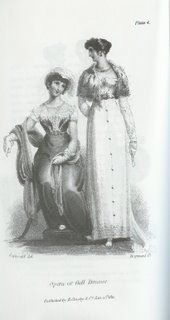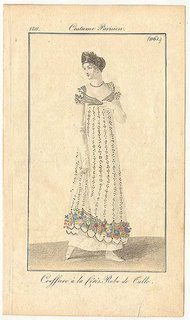
Having opened that nutshell, I don’t have the room for too many details. But as I was perusing two books this morning–one being REGENCY ETIQUETTE, The Mirror of Graces (1811) and THE FEMALE INSTRUCTOR (1831) it came home to me that there were prissy attitudes in dress and other attitudes in dress.
Regency affectionados sometimes believe there was just one way that things were–but most of us know that wasn’t so. Not to repeat myself (I may have said something along these lines before) but in the 60’s we did not wear Jackie Kennedy’s neat jacketed suits and pillbox hats, any more than we all wore mini-dresses in huge geometric prints. Or prairie dresses with flowers in our hair.
The lady (I assume both were ladies) author of REGENCY ETTIQUETTE had some amusing comments (not intending to be amusing, naturally). Here is one, regarding stays and corsets:
A vile taste in the contriver, and as stupid an approval by a large majority of women, have brought this monstrous distortion into a kind of fashion; and in consequence we see, in eight women out of ten, the hips squeezed into a circumference little more than the waist; and the bosom shoved up to the chin, making a sort of fleshy shelf, disgusting to the beholders, and certainly most incommodious to the bearer.
She has much to say on the subject of corsets, and also on the subject of a lady who, “of her own choice, ‘unveils her beauties to the sun and the moon.'” All of this suggests that there were ladies who wore stays and those who didn’t, and ladies who bared themselves in one way or the other–by means of low necklines or filmy material–and those who did not. Also, interestingly enough, the pictures published in this volume did not show examples of those you normally saw in women’s fashion publications in that year. The waistlines, for one, were almost at the normal waist and not high at all. (See the b & w scan above).
 The authoress of the 1834 volume has a similar opinion as the first. Immodesty and excess of dress are to be avoided, in her opinion, and “…do not be fools in order to be belles. Above all things consider decency and ease; never expose nor torture nature.” She also reiterated the first authoress’ opinion that one should dress appropriately to one’s station. It seems that even in 1811 there were concerns about girls of “plebian classes” dressing above their station.
The authoress of the 1834 volume has a similar opinion as the first. Immodesty and excess of dress are to be avoided, in her opinion, and “…do not be fools in order to be belles. Above all things consider decency and ease; never expose nor torture nature.” She also reiterated the first authoress’ opinion that one should dress appropriately to one’s station. It seems that even in 1811 there were concerns about girls of “plebian classes” dressing above their station.
The second scan is from Costume Parisienne of 1811.
The third is from Ackerman’s of that year (a mourning gown); the fourth is from Acerman’s, 1810, a ball gown.
Finally, the last lady is from Ackerman’s of 1812. I could not tell you which are the cit’s daughters and which are the peers!
Laurie



